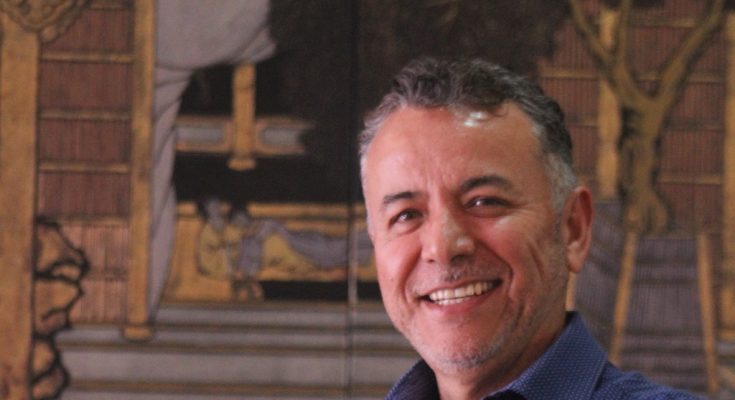By Jesús Aguado
After 80 years, airplanes have begun to be built again in Mexico. The Halcón 2 is a light aircraft designed and built in Guanajuato by Horizontec. This is being done with the participation of a local company directed by Fernando Balderas López, who is also responsible for the opening of the only engineering school in San Miguel de Allende. He first presented his engineering school project to the Offices of Public Education of Guanajuato at the beginning of 2000, and the first thing they said was, “There is no industry in San Miguel, where are your engineers going to work?” Today we do know where they are.
Fernando Balderas Martinez
The story of the head of the ITSSC engineering school begins in Ibarra, a rural community in Ocampo, north of Guanajuato. This is where Fernando Balderas Martínez was born, and is now the father of Fernando, Maru, Meche, and Juan Carlos. Balderas went to the only private elementary school in Ocampo, an educational center run by nuns. He was a diligent student and he was eventually invited to the seminary in León. But after high school, he realized that the religious life was not for him, and instead went to Mexico City to study law at the Escuela Libre de Derecho. He was a hard-working man, and that led him to work in the justice department. He came to San Miguel as a Judge. “He was a civic, criminal, commercial judge, even for the Plaza de Toros. The city was small, he was the only one in San Miguel, it was at the beginning of the 60s,” his son, Fernando Balderas López, told us.
Fernando Balderas Lopez
He has been living in San Miguel for 50 years, and he remembers how his life was living in Centro, on Mesones Street. He studied at the María del Refugio Aguilar Institute, he is the product of public schools. Everything was close then: the store, the pharmacy, the hairdresser, the bank. The streets ran both ways.
He received us in his current office, which is nothing like the one he worked in on Mesones Street. There, he had only one computer, and a table — which, by the way, was missing a leg.
On the walls of his office, there are photographs of the people who were instrumental in making his life what it is. There is, of course, a photograph of his father. There are also those of Engineer Gerardo Arredondo and of María de los Ángeles Romero. He remembers them fondly. Balderas recalled in our conversation that there was always enough in the house, but he was tempted to have some things that were not possible. In fact, he made lists of what was lacking in San Miguel, because he had an entrepreneurial vision. “I wanted to have my own company, I didn’t know what, but I wanted my own business,” he told us. In an easy conversation, he told us that as a child he always liked to “deflate” things. “I used to assemble and disassemble shit. Once I took them apart, some of them didn’t stay the same again — tape recorders, cassettes, water pumps, everything — I wondered how they worked. My parents didn’t want me to touch things anymore.” He also did not find mathematics disagreeable.
Pingüino Popsicles, and the young man who was ready
When Balderas studied at the FIMEE (Faculty of Mechanical and Electronic Engineering of the University of Guanajuato), he took advantage of summers and went to work in the United States. He would sell popsicles near the cathedral in Dallas, Texas. “I was supporting the business of an uncle in Oak Cliff. I would push a cart with popsicles and on Sundays, by the cathedral, I sold them all fast. We filled the cart several times.” He was a waiter, a busboy, and a dishwasher. Of course, he also studied English in San Miguel, he didn’t know when he might need it.
He completed his degree on a Friday, and on Monday he was already calling the CIDESI, Center for Engineering and Industrial Development of the National Council of Science and Technology. He met with Gerardo Arredondo (RIP), the sales director. The main points asked during the interview was whether he spoke English, if had a visa, and if he had ever sold something. “I had sold popsicles, if that counted,” Balderas said. He offered to work with CIDESI for ten thousand pesos a month (equivalent to current money); or work with Arredondo for three thousand pesos. “He had a company, NEOTEQ, he sold numerical machines, and ANSYS software among him. I had to market ANSYS.”
Balderas recalls that he decided to give up working for ten thousand pesos, and take the job for three thousand with NEOTEQ because he “had the opportunity to learn and grow. I would be my own boss, I could travel, sell, create clients. The software had a future. I liked the idea of not having to report someone. But, there were no ANSYS clients in Mexico, it was new. That’s how I started at 23 years of age. The computer I had was a 286. I would put like 500 floppy discs in it. There was no mouse, it was command. Regarding the software, at the beginning there was rejection, ignorance, and misinformation. It is not cheap software, they cost thousands of dollars. My first client was the Instituto Mexicano del Petróleo.” he told us. About the job he said that, “It doesn’t require someone to be ready, but to be ready when the opportunity comes.”
ANSYS and the School of Engineering
The story about the beginnings of ANSYS; its creators, distributors, sub-distributors, and how Balderas finally became a partner of the company is long. What is known is that ANSYS technology is used to “make new, different things, to test by means of computer simulation things that have not been tested, that do not exist, when there is no material or documents, simulation is used for that, to know if things are going to work out,” Balderas told us.
When he finally was representing the company in Mexico, Balderas decided to use San Miguel as his base. He opened his first office on Mesones in 1997. He did everything — he sold, he gave technical advice, he traveled. And when a company required consulting, it could take months. So he started hiring engineers to provide him with support, services, and so on. He went to the sales.
Balderas continued, “I had relationships with CONACYT Centers, Mexican Petroleum Institute, MABE, TREMEC; they were my first clients. Everyone agreed that there were no engineers focused on the use of technology. There were no engineers, and it’s true. Engineering educational programs were created to support the industries of power generation, maintenance, production, quality, that’s what they taught you. It was not academic programs designed to develop new products. They trained engineers who knew how to operate a plant, safety, maintenance, but not with a focus on product development, not innovation.”
He thought it would be important to open an engineering school in San Miguel. After preparing the academic program in early 2000, and submitting it to SEP Guanajuato, (Department of Education Guanajuato), they returned the folder to him after two years because there was no one to review it. With a building ready for classes, but without authorization for programs, the project was taken to the University of Guanajuato, and María de los Ángeles Romero made it possible. Thus the ITSSC became a school incorporated into the University of Guanajuato, and began operations in September 2004. The next year came the high school.
Balderas understands the SEP Guanajuato argument in not authorizing his study center: “Where will your engineers go to work, in San Miguel there is no industry?” His answer was succinct: “They are not for San Miguel, it is for them to work in the world. Wherever they please, engineers are needed all over the world.” Now the argument no longer resonates. “Do not create a university because there is an industry, the industry can come because you have the preparation,” he said. Today he is proud because his engineers are in the United States, in Europe, in South America, and even in San Miguel.
Halcon II
The ITSSC group provides and facilitates software to small companies, but it does so with projects. He is now a partner with Horizontec, the company responsible for the design, creation, and manufacture of the Halcón II—the light aircraft born and manufactured in Mexico after 80 years.
The Halcón is the creation of Giovanni Angelucci, and it was the star at the Bajío Aerospace Forum last month. This plane project received strong support from Balderas when he was president of the Council for the Attraction of Investments of the State of Guanajuato, because he saw a future for it. When he chaired that council, he insisted that technology-based companies be supported.
The idea was for Horizontec to settle in San Miguel, however, after reviewing more than 25 possible sites for airfields, none have been found to be suitable. It is possible that the aerodrome will be designed not only for Horizontec, but also for tourism, health, and emergencies. It will be for San Miguel because it has world-class hotels, and international awards. In the end, Horizontec will be based in Celaya, where they will be able to use the airport.
Balderas, proud to be the driving force behind the Halcón II, told us “it is a light aircraft, for two people. The first Mexican airplane in the last 80 years. It already flies, there are orders. It’s for pilot schools. If you want your own plane this will cost about $150,000. You can get to the beach in an hour and a half. It uses premium gasoline, and has a ballistic parachute, that is, if something happens, the plane falls completely safely. The materials are high-tech composites. It is designed and built in Guanajuato. Now what remains is that it is accredited to produce it en masse. It requires 40 flight hours, with 50 landings and takeoffs. It is a project that we should be proud of. Giovanni Angelucci is Mexican, and Mexican engineers work with him. It is a demonstration that we can do things.”




